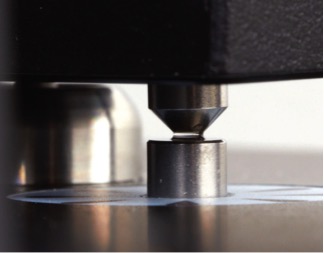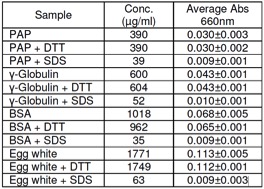Members Login

Channels
Special Offers & Promotions
Pierce 660nm protein assay using the Jenway Genova Nano
Introduction
The Jenway Genova Nano is preprogrammed with parameters for a number of protein assays, several of which can be adapted for use with the micro volume accessory. Performing scaled-down reaction volumes has a number of advantages including reduction in reagent and sample volumes and use of fewer consumables such as cuvettes.

Fig. 1: Read head of the Genova nano showing a sample in the read position.
This application note describes the use of the Pierce 660nm protein assay kit (Thermo Scientific #22662) using the Genova Nano. The assay is prepared in a microtitre plate using just 10μl of test sample and has a linear range of 50-2000μg/ml. The assay is very simple and quick to perform and is compatible with reducing agents and some detergents.
Results
The Genova Nano has a number of curve fit options; the unknown sample concentrations were recorded using the interpolate curve fit function. The standard curve (plotted using Microsoft Excel) is shown in Fig. 3 and shows a linear response over the standard protein concentration range tested.

Fig. 3: Pierce 660nm assay standard curve showing linearity over the complete concentration range tested.
Table 1 below gives the derived protein concentration results for the unknowns together with the average absorbance values. Note that the absorbance values are low due to the “virtual dilution” of the sample at the 0.5mm path length. Therefore only small changes in absorbance can cause a large difference in derived concentration. The standard deviations of the triplicate samples are very low and typically less than 10% of the total.

Table 1: Protein concentrations of the unknown samples derived from the standard curve on the Genova Nano.
The Pierce 660nm assay is known to be affected by certain interfering substances including ionic detergents such as SDS. This is borne out by the results obtained in this assay where the SDS significantly reduced the absorbance of the samples. An Ionic Detergent Compatibility Reagent is available as an additive for the kit for use with samples containing SDS. The assay is not affected by DTT at the concentration tested and this is illustrated in the results obtained which are comparable to samples which had no DTT added.
Conclusions
The ability of the Genova Nano to measure small sample volumes pipetted directly onto the read head, introduces considerable cost savings in terms of time, sample and consumables. This application note demonstrates that a standard cuvette-based protein assay can be adapted for micro volume use with minimal modification and produces reproducible results.
To find out more information on the Genova Nano or other Jenway products please visit: www.jenway.com or view an introductory video To buy the Genova Nano, please visit: http://www.bibby-shop.com/product/737501
For any further information or queries regarding Jenway products, please feel free to contact BSLjenwayhelp@bibby-scientific.com
Media Partners


